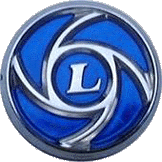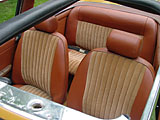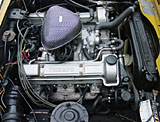


 |
 |
|||||||
© 2025 |
Technical Article: Stag CoolingSince lately I have been studying the cooling system of the original Stag engine, the generally accepted methods of maintaining cooling on a Stag that I've found are: have the radiator recored to a 3 or 5 row core or modified cross flow; make sure the original style thermostat with blanking disk is used on a Mark II induction manifold designed with a bypass hole in the back of the manifold. CAUTION - If you have an early Mark I manifold that does not have a bypass hole behind the thermostat hold, DO NOT use a blanking disk style thermostat as it may NOT OPEN. This is due to the fact that the shaft of the thermostat has no place to travel when opening, where in Mark II induction manifolds, the blanking disk shaft travels into the bypass hole when opening; retorque the intake manifold and cylinder heads every 3000 miles, 6000 miles maximum; pressure flush the cooling system once a year, replacing the antifreeze coolant with new; rod out the radiator every two years, or with #4; use only original style molded reinforced hoses; se only a 20 psi radiator cap on a Mark II, 13 psi cap on a Mark I; properly bleed the air out of the system. From the previous research and articles I've read, most folks seem problem free with the Stag cooling. Adequate Maintenance:It appears that only systems that have not been maintained, or not had a quality engine flush to remove the engine block sediments are actually having problems (I found about an inch or so of crud in my engine block when disassembled). My nose is tuned to the smell of antifreeze, and I panic when I smell it. Most of the time it is a passing car with a leak, but I always check it out. Six vs. Twelve Vane water pump impellers:The reports of the 6 to 12 vane pump impeller swap increasing cooling I would be suspect of, without first performing all the generally accepted maintenance and modifications first. Racing use:If any use of the Stag engine would cause a problem in the cooling, I would think it would be racing. Hart Racing recommend refitting of a higher capacity radiator. The information on cooling from Hart that I have read, and since Hart races Stags professionally, I would take their advice for cooling system maintenance. Removing the heat from the engine compartment through exhaust modifications should help also, which I bet that none of the racing engines at Hart have other than tubular exhaust manifolds. Cylinder head gaskets:I've also noted several different types of cylinder head gaskets. I do not know the manufacturer of each, but one style I've seen does not have hole openings that match the water jacket's semi circular holes in the block and cylinder heads. Where there is a semi circular opening in the metal, there is only a small round hole in the head gasket. The intake manifold gaskets also have a smaller hole than the hole for water flow from intake manifold to the cylinder head. These restrictions would impead the flow of water through the water jacket, causing less heat removal. Engine Block casting problems:On one block, the water passage leading to the water pump suction on one side had some casting flash bent up obstructing the pump suction by about one-half. I've read other reports of this problem. System Filling, air bleeding:Since the high points that can trap air in the system are in the heater coil and intake manifold, jacking the front of the car to cause the air to find its way out should be done over a period of time while at idle, and topping off the radiator. An air bubble in the wrong place in the cooling system could possibly interrupt flow on one side of the engine, and cause overheating or over pressure. Summary:To date, I think the above is a summary of what has been done by just about everyone who has owned a Stag. It only takes one time to overheat and rupture a head gasket or warp the cylinder head. From what I have read, the cause leading to the overheat was lack of proper maintenance. The best recommendation so far is...regular periodic maintenance. Who knows what I will come up with down the road, maybe only to verify that the general maintenance works fine. Regards, Glenn Merrell, 73 MarkII Stag Posted on Saturday, November 19 @ 21:01:58 CST |
6/7/2025        | ||||||